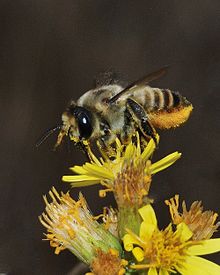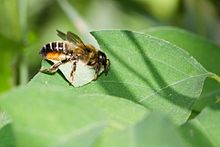- Megachile
-
Megachile 
Scientific classification Kingdom: Animalia Phylum: Arthropoda Subphylum: Hexapoda Class: Insecta Order: Hymenoptera Suborder: Apocrita Superfamily: Apoidea Family: Megachilidae Subfamily: Megachilinae Tribe: Megachilini Genus: Megachile
Latreille, 1802subgenera many (>50)
The genus Megachile is a cosmopolitan group of solitary bees, often called leafcutter bees. While other genera within the family Megachilidae may chew leaves or petals into fragments to build their nests, certain species within Megachile neatly cut pieces of leaves or petals, hence their common name. This is one of the largest genera of bees, with well over 500 species in over 50 subgenera. North America has many native Megachile species, though the imported Alfalfa leafcutter bee (Megachile rotundata) is the only truly important species used for pollination.
Nests are sometimes constructed within hollow twigs or other similarly constricted natural cavities, but often are in burrows in the ground. Nests are typically composed of single long columns of cells, the cells being sequentially constructed from the deepest portion of the tunnel outwards. The female places a supply of food (pollen or a pollen/nectar mix) and an egg in each cell, then builds a cap and a wall that separates the completed cell from the next one. The larva hatches from the egg and consumes the food supply. After moulting a few times, it spins a cocoon and pupates, often after several months of hibernation as a prepupa. Then it emerges from the nest as an adult. Males, which are typically smaller and emerge in advance of females, die shortly after mating, but females survive for another few weeks, during which they build new nests. Numerous families of wasps and bees will parasitize Megachile nests, most notably including Gasteruptiidae, Leucospidae, Sapygidae, and various cleptoparasitic Megachilids, including the closely related genus Coelioxys.
Various species in the genus, especially those in the subgenus Chalicodoma and related groups, do not use cut leaves to form the cells as in other species, but instead use fairly dry plant resin, which they carry in their mandibles. The subgenus Chalicodoma includes the world's largest bee, Megachile pluto, as well as one of the largest Megachilids in the United States, the recently introduced Asian species, Megachile sculpturalis.
Megachile species have no lobe (arolia) between their claws and thus are unable to climb smooth (glass) walls.
Diversity
Approximately 1500 species, this is an incomplete list:
- Megachile rotundata, alfalfa leafcutter bee
- Megachile pluto, the largest bee in the world
- Megachile sculpturalis, giant resin bee
- Megachile perihirta, western leafcutting bee
- Megachile fidelis, faithful leafcutting bee
Shelters for Megachile
External links
Categories:- Megachile
- Pollinators
Wikimedia Foundation. 2010.





